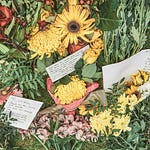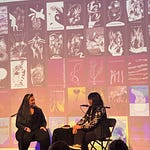This is Five and Nine, a podcast newsletter at the intersection of magic, work and economic justice. Welcome to Season 1, Episode 4. We are pleased to share we are now available on Apple Podcasts!
Listen to the podcast now, or read the transcript below, or both!

Resources
Music
Dance of the Songbirds, composed by Benjamin Richmond and performed by Joseph Belmont (the whistler) and the Victor Orchestra in 1913.
Our Guest’s Work
Unspooling Die Gramgewinde: Writing with Gunta Stölzl on Grief-Threads and Grief-Portals, by Indira Allegra in Textile
Texere: The Shape of Loss is a Tapestry, at Minnesota Street Project, visible at Texere.Space [password: weave]
Othe Resources
Taking a Thread for a Walk at the Museum of Modern Art (MOMA)
Mumurations Tarot Deck by AS220
Seventy-Eight Degrees of Wisdom: A Tarot Journey to Self-Awareness, by Rachel Pollack
Tarot Cards:
Eight of Swords
Seven of Cups
The Tower
Queen of Pentacles
Transcript
Dorothy: We have a special guest today. We haven't had one yet, so this is a momentous occasion for us at Five and Nine. It is the incomparable Bay Area-based artist Indira Allegra.
They are a conceptual artist, but there's so much more than that. And we'll talk about that. They are also a recognized leader in the field of performative craft, which I hope we are able to get into.
So, you know, obviously working with weaving, the loom and using that as a framework for exploring these kinds of tensions that haunt both non-human and human relationships. A lot of the things that they've been working on is a combination of past experiences, within sign language interpretation, domestic violence, counselor, sex worker, union organizer.
And so, so, so much more, and if we kept this going it would be the whole podcast. We're not going to keeping going, but this is Indira Allegra, and welcome!
Indira: Thank you, Dorothy, for that introduction. I'll try to live up to everything you've read.
Dorothy: I will say — and I'll put this on record because we were on a podcast — Indira's worst day is my best day. Just to put it out there right now.
Ana, Xiaowei and I, we've had many discussions regarding the differences between work, labor and career. And so, for example, when you think about something such as labor, what are the mechanisms that are needed to kind of make something come to fruition versus work, which is like the every day? Some people might even think work might be something lik, David Graeber's Bullshit Jobs.
So work is a thing that allows us to survive as much does, but then career sometimes can be this abstract thing, this always changes for us. But within the arts, do you feel there is a distinction between those three, and how have those lines blurred, or how have they become much more clear during the pandemic?
Indira: Okay. All right. Well, let's just start with the questions then!
Okay, so actually, I would say that first, you’ve got to figure out what your calling is, and then you can mobilize your career to be in service of that. And then the labor is like all of the details which make your career possible.
So I think that for me, on a much larger level, I do work of holding transformational space, holding the space of the portal, or being there with both human and non-human co-conspirators so that transformation can happen. And sometimes that transformation involves a death process. Sometimes that transformation involves the development of understanding. You know, like with my work, as a sign language interpreter, to be the body that holds the text for two people who wouldn't otherwise be able to communicate with each other easily.
So I think that you can have a calling, and you can have many different careers, which are in service of that calling. You know, hence the work as a union organizer and being with people who are in this transformational place of realizing that they have work in the workplace as it exists anymore.
And that there is a boundary for them internally around what they are willing to live with and what they're willing to work with. And more importantly, there is a world that they want to move into and be ushered into in terms of what their workplace could feel like and how it could operate for them.
Yeah. So maybe it's even a kind of doulaing work, but I think that births and deaths and transformations of all kinds are happening all the time. I think to live is to lose and to learn how to do that. I think within the space of an art practice, what I'm able to do is to work more closely and more regularly with non-human conspirators or co-conspirators or performers.
Whereas if I were to have stayed in the realm of doing interpreting or even the realm of sex work, the focus would be more on the human to human interaction. And I think it's actually really important to be thinking big picture in a way, which decentralizes human concerns, conceits, and when we can do that and kind of almost like a bit is turning the human volume down.
I know that Ana's in the producer role, like at the controls. And so Ana is balancing the sound of my voice with the sound of the room noise. And what if actually the room noise and my voice were at the same level? And what if that was at the same level as the trucks going down the street outside? With the bird songs, all of that stuff. That would be an artwork, an art assignment or a sketch or something to try, to listen to one's environment where you're at the same level as everything else, which is happening around you, and how might that impact how one feels about animacy and power and also access to resource.
If a bird songs as loud as my voice, then maybe it has the power to impact something in my life in a really powerful way too. I think we're used to, as humans, thinking about other sounds as being smaller than our own. And so then we're unable to connect with their spiritual or intellectual resource. Maybe there's an intellectual resource in the bird's song that I need.
Xiaowei: I think you brought up transformational space and the non-human, and I'm curious, both in your art practice as well as holding transformational space, and being in the world that we live in, that we have to eat and pay bills and all these things. How do you draw these lines, like of self and non-self either in your practice or in holding transformational space?
Indira: I'm smiling right now because I think that's more mutable. I'm interested in thinking of the self as maybe more mutable than — like most people, I think I like to think of the self as being fixed , finite, you know, something which is reliable and can be counted on. And I don't know, as a non-binary person, I feel like — I just feel like a lot of things are in flux all the time. How do you know who you are?
I think we only know who we are in relationship to other folks, right? I know where the earth is, because I know where the sun is in relationship to that. And I know where the moon is in relationship to that. But what if the moon drops out? Where am I located now? I have to re-situate myself within a new network of relations.
That's the grieving process, right? It's learning how to accept that a loss has occurred, that a death has occurred. And trying to figure out a new constellation to fit into. So I think the self is always changing in relationship to the losses we experience in our lives. I have a name which will follow me throughout the long arc of my life, but I think that there are many different selves which can exist within that name.
The Xiaowei that you will be at the age of 90 will contain many different selves. I think that's really a beautiful thing. So I do think of myself as a collection, a multitude. That's where the they/them comes from with my pronouns. It's not only stepping outside of a masculine or feminine binary, but thinking about all the different ages that I have been, all the different ages I will be, all of my ancestors, all of the nonhuman parts of which I am constituted. It's a way to tip my hat to each of my white blood cells and my red blood cells and the vessels they're in, you know?
Xiaowei: There are so, so many things that I feel like you have such wisdom on. I've noticed, even within birth doulaing, it's like, there's the beauty of the work itself in holding the transformational space.
And then there's also the kind of realities of — in many ways you're doing client work in a lot of senses. That makes me think of art institutions. And so, I think I’m just curious about, what are the ways that you can — I would hesitate to use the phrase "stay true to your practice," but I guess I'll use that as a proxy. And also, where you are now having this capacity as a full-time artist and like supporting yourself on that?
Indira: I mean, really, it is a faith-based practice. I will say that the bulk of my income comes from grants, awards and fellowships. My practice up to this point has not really been in the commercial realm so much. Yeah, and, and that's a very competitive way to get your coin.
I don't know what it's like in other realms, but I think that the odds that artists have to contend with when applying for grants or fellowships of any kind are really massive. But then I think about when you have thousands of people applying for a thing, and then there's multiple rounds that you go through.
And then after the round, there may be an interview and then a year later after the initial application, you'll know whether or not you got it or not. And there's letters of recommendation. There's all sorts of different rituals, which have been created around what one has to do to deserve funding, right?
I think about the odds that I've had to contend with in my own life around difficult circumstances, around instances of violence or illness or homelessness or disability. And I think about, oh, you know, damn, well, if I can survive that, then maybe the odds of winning this award — maybe I don't need to be worried about that so much. Money is not the most difficult thing. It's enough to live.
[14:34] Ethos and Art
Dorothy: There's an ethos on your website, which I feel oftentimes is not something that people incorporate into their artistic or creative practices. I mean, this is something that people should just incorporate in their daily lives personally, but I so deeply appreciated — and I'm obviously familiar with your work and I've written about it, full disclosure to those out there. But it’s one of the things that we wanted to pull, because it is a brilliant list of statements that almost serve as a type of rider.
Indira: Yeah.
Dorothy: Both non-human, human, institutions, organizations, collectives, and a few that we pulled out were, number one, there is no such thing as a quote-unquote blank or open space geographically, visually, or ideologically.
Another line from your ethos is, build an altar to your creative and intellectual ancestors, tend to it. Please visit indiraallegra.com to really view this wonderful list. But the third one that we pulled that's related to grief and loss was loss is a normal part of the human experience, so attention to grief and loss is always timely.
We pulled those three out because we wanted to kind of have a conversation around how grief and loss actually is something people need to remember when you're thinking about economic justice.
Indira: That's right.
Dorothy: So when we think about this ethos and some of the ones that we just mentioned right now, this is a part of the work.
This is exactly what you were stating and what you said. You know, and this is also related to the abundance versus kind of scarcity ideas that Ana, Xiaowei and I have been talking about, not just on the podcast, but just even in life. And so I guess, related to the ethos, because we wanted to kind of set this up here, with your most recent project Texere. You know, it explores different types of digital weaving practices that actually encourage reflection and grief and loss and how they're woven into other participants. What in doing the project has it revealed to you about the way we need to survive?
Indira: Well, first I want to say thank you for looking at the ethos on the site. It has been amazing to — when people really go there and, they read through it. It's something that I've been surprised how many people really welcome seeing that information out in the public.
And I love that you use the word rider. Because it does function in that way for me. I think that my union organizer self is always concerned with the terms and conditions of any kind of economic partnership. You can go online and you can research a hundred different interviews that I've done, or like whatever.
Or you can just read it right there. I'll just tell you what I'm interested in. I think it helps me to curate the kinds of folks who find their way to me. When thinking about the semiotics of cloth or the anatomy of cloth, we do typically think about the warp and the weft.
I speak also of the spaces in between the threads being portals of activity. And for those of you who are textile nerds out there, there's an article that I published in the Textile journal, which is based out of the UK called "Unspooling Die Gramgewinde: Weaving Grief-Threads and Grief-Portals with Gunta Stölzl," who was a weaver for the Bauhaus.
And we know that something is woven because of the pores that it has. And it was surprising to me that no one had actually ever written about that and never written about the potential of these spaces. And I remember after my last trip abroad — travel was very important to me in the beforetimes.
I come back to New York from spending a couple of months in Europe. And I went to an exhibition Taking a Thread for a Walk exhibition at MoMA. One of Gunta Stölzl's wandbehang or wall hangings, was there. And I began to cry in the presence of this cloth. I began to cry because I'm a sentimental person. I began to cry because I just fucking cry at museums because they're contemplative spaces and I am really moved in social spaces where there are contracts around thoughtfulness and silence.
And I began to cry because I felt that that that cloth was pulling something out of me, that there was something in those pores that was actually like drawing a kind of grief thread along a Z axis. It's like you have your X and Y axis that you’re used to thinking about. And then this other axis, which is like between the space between my body and the body of the weaving. And I got really interested in that.
So I think that brings us to Texere: The Shape of Loss is a Tapestry, which is a solo exhibition of the Minnesota Street Project right now through April 30th. This is a collection of digital memorial tapestries, which honor different losses in our lives. So there are eight different categories of losses, including the loss of force to wildfire, loss of sleep, or loss of a loved one to a virus.
What you can do, and all of you can do it here, and anyone who's listening to this podcast is welcome to do this as well, is you can go to texere.space online. The password that you need is weave, all in lower case. You can make a contribution to any of these tapestries. So say, for instance, you wanted to contribute to the loss of forests to wildfire. And that was something that maybe if you're here in California has impacted you. And I know that that's something that has impacted me deeply.
What I might choose to contribute would be either text or an image, or even an audio recording about that loss. And then I can use texere.space to turn that text, image or sound into a thread which then gets uploaded or woven into this tapestry, which is now hanging in space. And so you're able to see your contribution woven in with other people's losses or other people's contributions to that.
And it was important to me to work in this way, which can create memorials that change as we change in relationship to our losses, the same way that I felt it's important to acknowledge how the self is always shifting, right? What we talked about before when Xiaowei asked me that question.
The memorials we need also need to change as we change. The prevailing way of thinking about memorial at this time has to do with something which is cast bronze in the middle of a public square, which few people care about after it's installed. The things which matter to people the most when I ask folks about memorial are the keepsakes on their dresser in a bedroom or something which is kept on the top of a fireplace or images in one's phone. So it's the stuff which is really close to you in your life, right? I think that we can use this through Texere to care for us as we move through our losses.
[22:33] Tarot Reading
Dorothy: D we have consent to pull a card or two?
Indira: Yeah, please.
Dorothy: And the three of us would love to provide our own thoughts. Is there anything top of mind?
Indira: So one of the things I've been doing over the past few months is learning how to read charts. So for astro nerds out there,1 Neptune and Jupiter just had a big conjunction in Pisces, which means that the ancient ruler and the modern ruler of Pisces were at home together in the same sign or are at home together in the same sign. Venus and Mars are also transiting through Pisces right now, so there's a lot of activity which is happening in this very watery sign, which is associated with the 12th house, which can be a space between life and death and can also be a place where stuff is very unconscious, even within ourselves and takes a bit of work to define.
All that is to say is I have been feeling tremendously emotional during this time. I feel like there's fresh grief around old grief, which has been coming up for me , and I'm always curious about other kinds of grief practices or rituals that I can incorporate into my day. That's the background to the question. How do I care for this grief that I'm experiencing right now?
Dorothy: Mm. All right, so I'm going to pull a couple cards…
And the first card I pulled was the Eight of Swords. It's an image of a feminine figure blindfolded with swords, kind of staked into the ground. She is bound, and there are a lot of ivy leaves in the background, as well as a panel of purple and hues that are bluish pinkish.
And then the second card I pulled, it's the Seven of Cups.
Indira: Oh, wow. Illusions abound!.
Dorothy: Yeah. Or, you know, the imaginary liminal space, but yes, absolutely.
The Seven of Cups is a masculine figure in the foreground, looking up at these seven cups in these different cups, they're golden goblets. They contain different types of figures: a dragon, a wreath, jewels, the tower that we might see in the Tower card, a serpent, a figurehead, and then a bit of a a hidden figure. Those kinds of elements that we see in the Seven of Cups.
So let me hand it over to Ana and Xiaowei.
Xiaowei: I'll start with the Eight of Swords. I'm actually using a new deck that I haven't used before. And it's by a series of artists from Art Space 220 in Providence, Rhode Island, the Murmurations Tarot Deck.
And in the Eight of Swords in this deck, it's similar where there's like knives surrounding this feminine figure, but there's actually this latent strength, and the feminine figure, like their feet, their legs are quite muscular. And there's like one knife like in those secret agent movies where it's like, the knife is like in the garter belt. And it's like, oh, but I've got this one secret knife that I can always take out.
And so I don't know, like a sword, there's the double edge of both the kind of grief and anxiety and anxiousness that pulls one back. And then there's also that sword as a kind of secret power, and so I don't know, I feel like your work speaks so much to grief and loss, but there's also this kind of latent strength and secret power.
I'm curious how that resonates for you.
Indira: I do feel like how I was talking about the 12th house. Right now I feel the presence of something, which is a resource. I know it's in the room. I know it's on stage with me. Yeah, but it's like, I don't have an ID on it. If that makes sense.
Xiaowei: That kind of giving name to that latent power feels like a way to tend to tend to it.
Indira: Thank you.
Ana: To me, the Seven of Cups— there's the Rachel Pollack interpretation and in their book, Seventy-Eight Degrees of Wisdom, it's about getting lost in visions. But I like this idea — what I love about the Seven of Cups, it's such a beautiful image of many things coming together, many practices, objects, spirits, visions.
And it makes me think so much of your work, Indira, of Texere. That this work you're doing of weaving together people's stories and lives. That this time of grieving is a collective one. This time of grieving is both individual stories, but we're all weaved together right now. The sadness is bringing up old sadnesses for us. It's a collective kind of action at the same time.
And I always liked the interpretation of the Seven of Cups as a way to understand the visions that you're looking at, to name them, sit with them, be present with them. And to me, what's so powerful about the work you do, your calling, as you say, Indira, is that it's both highly individual, highly specific, but also incredibly collective at the same time.
And it just reminds me of a Buddhist teacher who said that sometimes these moments of grief, of sadness, they remind us of how not alone we are because they connect us. That pain connects us with other people and reminds us that we need other people, we need these stories.
Dorothy: Yes. Plus 1000. All the things.
Thank you, Ana, for that mention of Texere. I almost see the Eight and the Seven or the Eight of Swords and the Seven of Cups as basically the warp and the weft. Eight numerologically in tarot is that of action. So what is this figure going to do to unbind herself and find her way through the swords?
Because there is an opening, actually, there is a couple in the Rider Waithe depiction where she is not fully enclosed. And so think about this kind of woven nature. If we think even how, if you look at how the figure itself is painted on, there is intersections and crossing over. But then when you talked about, well, there is an opening in between the warp and the weft and those are portals. Well, that is the Seven of Cups.
So I love that the two cards are showing us what we've already been talking about this whole time. The reason why I think Ana, Xiaowei, you and I believe so wholeheartedly in this magic of tarot and what it tells us and how we create and how we create, generate and bring into existence these different narratives through all these different art forms, but especially thinking about your practice and how going back to your original question of like holding the grief, processing it. And I feel these two cards are so indicative. I feel tarot always tells you what you know, on top of having a huge sense of humor.
Indira: Yeah, no, definitely on the humor piece for sure. Oh my goodness. I'm very grateful. Thank you. Thank you to each of you.
[31:47] Queen of Pentacles
Dorothy: The other thing is just because inquiring minds want to know is — we want to know about the Queen of Pentacles.
Indira: That's so funny. So for those of you who are listening, I'm using my headphones to record this interview, and I name all my devices. Yeah, which I feel like for me is a way of engaging in practical magic around the practice of address. So in the same way that I love being addressed as they/them, because it invokes so many different types of power.
I love being able to address my devices in the same way. And so Queen of Pentacles for me speaks to the kinds of resource that come to me through podcasts such as Five and Nine and other music that may be — I'm a big playlist person, so music is a huge resource for me, both emotionally, and in terms of thinking about moving my body.
And thinking about phone call and voice node and other forms of conversation as being such a place of resource for me. I am a hard of hearing person myself. When I put my headphones on, there's just this space of intimacy and clarity, which comes through for me through the voice.
Five and Nine is a podcast newsletter at the intersection of magic, work and economic justice. We publish “moonthly” — a newsletter every new moon 🌚 and occasional podcasts on full moons 🌝 — , and we provide an ongoing critical discussion through readings, reflections and debate. In this new world, we’re all rethinking the meaning of work and justice in our lives. Our lives and livelihoods are more essential than ever in identifying ways forward for society that can be grounded in care, compassion and sustainability.
During our pilot period, every issue of Five and Nine is free, and after the pilot, we’ll publish more regularly, with paid and free options. Learn more about us here.
Directors of Magic. Dorothy R. Santos and Xiaowei R. Wang
Creative Director. Xiaowei R. Wang
Producer. Ana Mina (aka An Xiao)
Subscribe now to get our next newsletter. As a podcast newsletter, Five and Nine brings the conversation to text and sound. All podcasts are fully transcribed to encourage accessibility.
Producer’s note: this reading was done on April 15, 2022, so the astrological occurrences are reflective of that period












